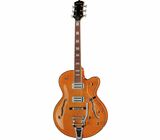I'm writing this review whilst looking at a BigTone Vintage Orange hanging on my wall. It's a really beautiful instrument, every bit as nice as the product photos promise.
Quality of finish is very good - the orange lacquer, binding and inlays look great. There were a couple of cosmetic issues with my guitar, but nothing that required a return. As with most guitars at this price point, you?ll need to spend money or time on a full setup when you receive it.
Hardware quality is excellent. I might upgrade the pickups for some additional ?twang? in the future, but the stock ones are capable of a wide range of tones. If you?re looking for warm jazz tones, you won?t be disappointed.
Personally, I think the guitar looks more classy without the scratchplate. It?s an odd size and doesn?t serve any purpose as the strings are so high. The two tiny holes left after removing the scratchplate are easily disguised - pop in a couple of flat-head panel pins, and it looks fantastic.
As far as playability goes, this beast takes some getting used to, especially if you mainly play modern solid body guitars.
First, this guitar is massive! The lower bout is 16? and the body is 3.5? deep. For me, this makes the BigTone strictly a 'sitting down' guitar. The tremolo works smoothly, and feels like wrestling a boat anchor in comparison to a modern tremolo. But, these are not criticisms - rather, all part of the vintage charm that makes this an extremely entertaining instrument to play.
You will get terrible feedback if you try using high gain amp settings. That's down to the hollow body construction. And it really is hollow! Other than a 2?x1? support post under the bridge, the body contains only air. There's no centre block, no bracing of any kind. Solution? Don't use high gain settings. This is a guitar for jazz, vintage Chet Atkins picking, perhaps a little Duane Eddy and a dash of Stray Cats. High gain has no home here.
Last, there's that vintage style bridge and tremolo. I think the design is lacking here. The tension bar pulls the strings close to the body, and the bridge is very high. This create a steep string angle, putting lots of stress on the poor bridge - a fragile wee thing consisting of a loose strip of wood with two threaded metal posts and the roller bridge on top. The end result? The bridge slides around when you use the trem, and you can see the fragile bridge support posts straining under the load.
My solution was to raise the tension bar by 6mm with metal washers under the tremolo body (at the two screw points). This eases the string angle and reduces stress on the bridge. I can now intonate the bridge properly, and abuse the tremolo without anything moving around. Hopefully I've increased the life expectancy of the fragile little bridge too.
Bottom line? If you?re looking for a big vintage hit of orange & chrome guitar lovelyness for not much money, look no further. I absolutely love it.


